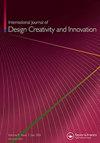刺激的形式及其在创意度量和非显而易见性方面对创意产生的影响
IF 2.5
Q4 ENGINEERING, MANUFACTURING
International Journal of Design Creativity and Innovation
Pub Date : 2020-05-20
DOI:10.1080/21650349.2020.1766379
引用次数: 23
摘要
人们公认,创意的产生得益于有意管理的刺激或设计师的过程,包括寻找外部灵感来源。基于文本和图形的刺激形式在设计文献中最受欢迎,但尚未证明哪种形式对提高创造力最有效。这是因为以前的研究采用了许多不同的条件,不允许进行比较。本文提出了一个实验,要求三组27名参与者为新生儿的服装提出新的想法。为了完成任务,参与者首先考虑以其中一种形式呈现给他们的五种刺激,这取决于参与者被分配到哪一组,即文本、图片或组合(两者并置)。刺激旨在共享语义内容,从而限制由于不同含义而产生的潜在偏见。实验的结果是根据创造性和非显而易见性来评估的。图像维度的存在导致思想的稀有性和非显而易见性显著增加,但不影响质量、独创性或数量。这三种形式产生的想法之间的有限重叠表明,开发混合多种形式刺激的想法生成设计工具具有潜在价值。本文章由计算机程序翻译,如有差异,请以英文原文为准。
Forms of stimuli and their effects on idea generation in terms of creativity metrics and non-obviousness
ABSTRACT Idea generation is acknowledged to benefit from intentionally administered stimuli or designers’ processes that include the search for external sources of inspiration. Text-based and graphic forms of stimuli are the most leveraged in design literature, but it has not been yet demonstrated which form is most effective for boosting creativity. This is due to the fact that previous studies have employed many varying conditions which do not allow for comparisons to be made. The present paper presents an experiment in which three groups of 27 participants were asked to generate new ideas for new-borns’ outfits. To perform the task, the participants first considered five stimuli presented to them in one of the forms depending on which group the participants had been assigned to, i.e. textual, pictorial or combined (juxtaposition of the two). The stimuli were intended to share the semantic content, thus limiting potential bias due to different meanings. The outcomes of the experiment were evaluated in terms of creativity and non-obviousness. The presence of a pictorial dimension resulted in a significant increase in terms of rarity and non-obviousness of ideas, but did not affect quality, originality or quantity. The limited overlap among ideas emerging from the three forms suggests the potential value of developing design tools for idea generation that mix multiple forms of stimuli.
求助全文
通过发布文献求助,成功后即可免费获取论文全文。
去求助
来源期刊

International Journal of Design Creativity and Innovation
ENGINEERING, MANUFACTURING-
CiteScore
3.80
自引率
27.80%
发文量
15
期刊介绍:
The International Journal of Design Creativity and Innovation is an international publication that provides a forum for discussing the nature and potential of creativity and innovation in design from both theoretical and practical perspectives. Design creativity and innovation is truly an interdisciplinary academic research field that will interest and stimulate researchers of engineering design, industrial design, architecture, art, and similar areas. The journal aims to not only promote existing research disciplines but also pioneer a new one that lies in the intermediate area between the domains of systems engineering, information technology, computer science, social science, artificial intelligence, cognitive science, psychology, philosophy, linguistics, and related fields. The journal covers, but is not restricted to, the following topics: ·Theories on Design Creativity and Innovation ·Cognition of Design Creativity ·Innovative Process ·Inventive Process ·Analogical Reasoning for Design Creativity and Innovation ·Design Synthesis ·Method and Tools for Design Creativity and Innovation ·Representation of Design Creativity and Innovation ·Education for Design Creativity and Innovation ·Concept Generation and Inspiration.
 求助内容:
求助内容: 应助结果提醒方式:
应助结果提醒方式:


